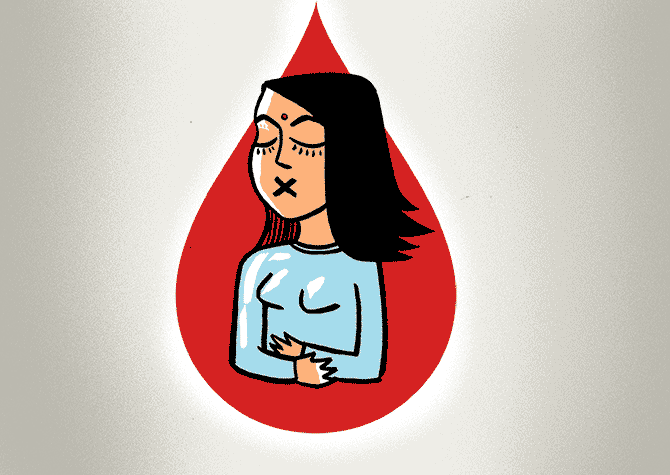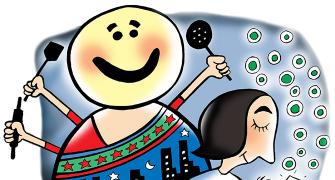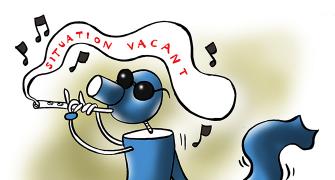'Emojis were conceived to add a dash of pizzazz to our text lives.'
'That's what they do still.'
'Hoping that they will usher social change is optimism on steroids,' says Shuma Raha.
Illustration: Dominic Xavier/Rediff.com

So you think emojis are cute little thingummies to liven up your text messages?
A smiley face or a big grin, an angry scowl or tears of joy, a wink or an eye roll, an applause or a mug of frothy beer -- they're fun to use, right?
Sure, they are. But these days emojis, the hugely popular visual shorthand for an emotion or an idea, have also become a hotbed of serious cultural messaging.
Diversity, inclusiveness, gender equality -- you name it and you'll find the emoji keyboard on your smartphone trying hard to do it all.
Hence, apart from the traditional comic book yellow faces, emojis now come in a variety of skin tones.
Last year Unicode, the coding consortium which standardises emojis across mobile devices, agreed to Google's proposal to add 11 new professional emojis in both male and female avatars and with all the skin tones.
Once seen only in the form of a dancing girl or a bride, you'll now find a woman as a doctor, mechanic, techie, chef, chemist and so on.
There are emojis depicting same-sex families as well.
That's not all.
The list of 56 new emojis to be released by Unicode in July includes images of breastfeeding, a hijab-wearing woman and gender-neutral persons.
And lest zombies and mermaids feel excluded and start a campaign to get due representation, there are emojis for them too.
Which brings us to the latest effort to take the emoji universe a notch ahead in this righteous game of representation.
Child rights body Plan International wants Unicode to incorporate a 'period emoji' -- an icon that depicts menstruation.
It feels this would help remove the stigma around menstruation that a lot of women face.
Last month, the charity launched five period emoji designs and invited people to vote for the one they liked best.
'It will start a conversation, and raise awareness of the challenges women and girls face worldwide,' Danny Vannucchi, Plan International's campaign manager, told Reuters.
One doesn't know Unicode’s response to the campaign. But voting on the designs has been vigorous and online communities (mostly of women) are buzzing with approval.
Of course, some men are saying that if a period emoji is kosher then there should be one depicting a male bodily function too.
That's just men being men. Gross.
But seriously, would having a period emoji really help extinguish the taboos around menstruation?
Or is it just another pointless tokenism that serves more to gratify the activist brigade than to lend any real heft to the cause?
After all, what exactly is the 'conversation' that we hope to start by sending someone an emoji like that?
If a friend, partner or a boss is insensitive to the pain and problems of a menstruating woman, would he get chatty about it if he were to be sent an emoji of an under garment decorated with drops of blood?
Indeed, one of the beauties of emojis is that you can avoid having a real conversation.
You can just send some emoji in reply -- a smiley or a straight face -- and the other party will be left guessing your real feelings.
There's no doubt that the stigma around menstruation is frighteningly real in many parts of the world.
Women are shamed and made to feel unclean for a perfectly normal biological function.
In parts of rural Nepal, menstruating girls are penned outside the house like animals.
In India a misogynistic patriarchy conditions us to not participate in pujas and ceremonies during that time of the month.
Women are also routinely described as 'hyper' or 'hysterical', as though they were slightly unbalanced creatures ever in the grip of their out-of-control hormones.
In his disgusting comment about Fox News host Megyn Kelly in 2015, Donald Trump, the US's boor-in-chief, probably echoed the attitude of a lot of men when it comes to menstruation: 'She had blood coming out of her... wherever,' Trump said.
The casual misogyny and taboos around menstruation need to be fought. But they need to be fought with education, with awareness programmes for girls and boys.
A period emoji is unlikely to do the trick.
Besides, girls who are stigmatised the most usually belong to disadvantaged communities.
How many of them have access to smartphones, and hence emojis to flag their state of body and mind?
Of course, emojis have become a part of our everyday communication. They have become powerful visual cues, almost as effective as words or gestures.
According to some estimates they are used by 90 per cent of the world's online community.
So one understands the urge to make the ever-expanding emoji universe an inclusive space -- a space that offends none and caters to all.
But there is such a thing as over politicising every aspect of our culture.
Emojis were conceived to add a dash of pizzazz to our text lives. That's what they do still.
Turning them into a checklist of political correctness is ludicrous.
Hoping that they will usher social change is optimism on steroids.
Unicode could unveil a period emoji or one for a runny tummy, but let's not kid ourselves that it will serve any grand purpose.










